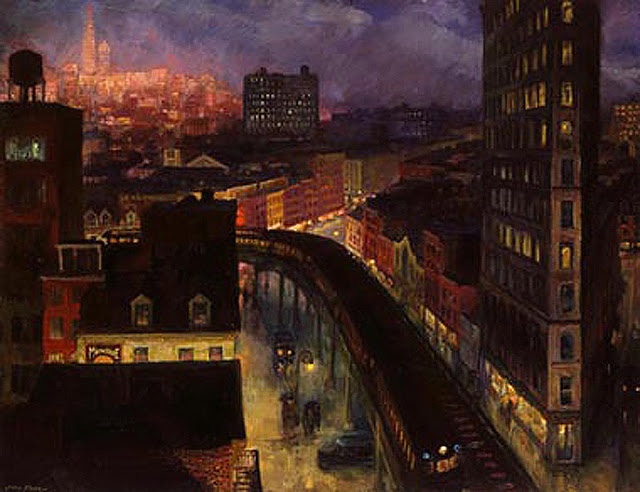John Sloan’s well known painting “The City From Greenwich Village”, painted in 1922 and now hanging in the National Gallery of Art in Washington, D. C., is a prime example of the Ashcan School, called that because it focussed on the grimy realities of city clutter and constant construction and the working class people who lived there. The painting remains striking because it provides a distinctive and very American view on the nature of city life, one quite different from the idea of urban life found in British, French and French presentations of citylife. James Whistler takes London bridges and turns them into swathes of dark color on a dark background to create paintings that are forerunners of Rothko. Cezanne fills the wide boulevards of Paris with crowds of people. Ernst Kirchner and other German Expressionists portray a Berlin crowded with strange looking people enjoying the nightlife. Sloan emphasizes, instead, how important is the physical aspect of cities, both the architectural structures and the architectural infrastructure. Spatial relations are more important than ethnicity or crowd psychology in explaining citylife.
Read MoreWenglinsky Review
Thought-Provoking Essays Include: A Short Post on Race, The Politics of Drag Queens, The Fundamentals of Social Roles, Radical Sociology, Women Are An Attractive Nuisance, The High Victorian and the Late Victorian, Tara Westover's Educated, The Stratification of Disability, The Philosophy of Education, Comedy and Tragedy in Pride and Prejudice, Jane Austen's Conservatism, Samuel Johnson's The Life of Richard Savage
A Fresh Take on Timeless Columns: Re-release: Shakespeare's Greatest Melodramas, Re-release: Why Noam Chomsky Is Wrong, Re-release: The Importance of Lady Windermere's Fan, Re-release: The Fundamentals of Social Roles, Re-release: Kahneman's Fallacies, Thinking, Fast and Slow
Film Reviews: The Moral Lessons of Now, Voyager , Woody Allen's Crimes and Misdemeanors, The Third Man, with more here.
Archives: Art Criticism, Jane Austen, Shakespeare, Philosophy, Literature, Social Structure, Religion, Politics, Everyday Life, Roles, Film, War, Education, Favorites, and Primers.
To receive a brief e mail about new posts, go here.

